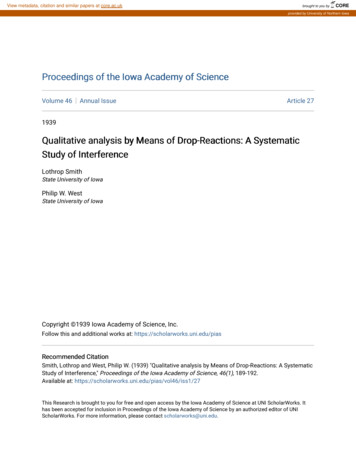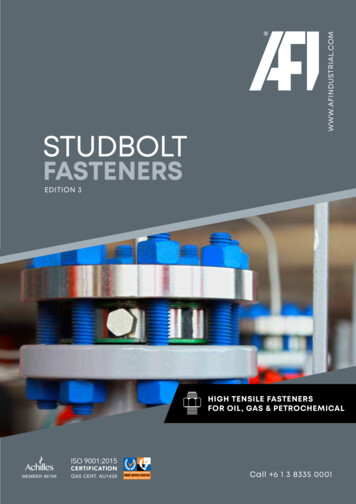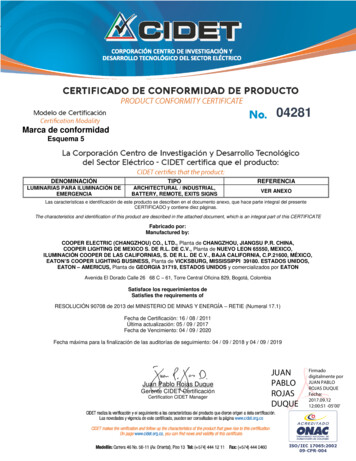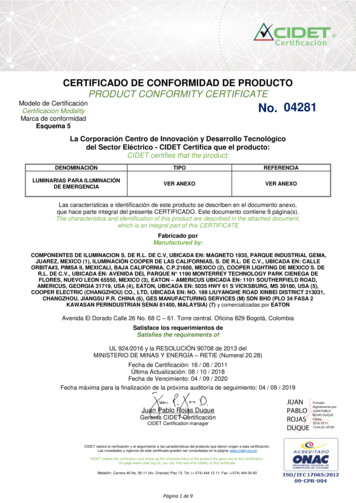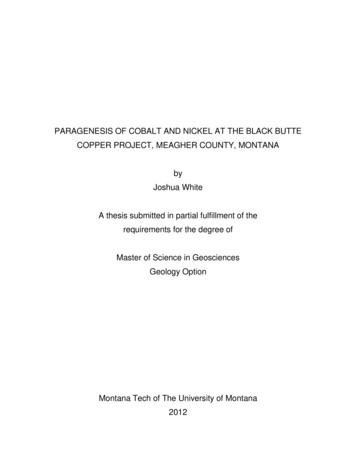
Transcription
PARAGENESIS OF COBALT AND NICKEL AT THE BLACK BUTTECOPPER PROJECT, MEAGHER COUNTY, MONTANAbyJoshua WhiteA thesis submitted in partial fulfillment of therequirements for the degree ofMaster of Science in GeosciencesGeology OptionMontana Tech of The University of Montana2012
iiAbstractThe Black Butte Copper Project (formerly known as the Sheep Creek deposit) is a sedimenthosted, laterally extensive massive sulfide deposit hosted in the mid-Proterozoic NewlandFormation in Central Montana. Formation of the deposit occurred during two stages ofmineralization: Stage I occurred during deposition of sediment in the Helena Embayment, andStage II occurred post-deposition. Stage I mineralization is characterized by a large quantity ofporous pyrite hosting significant Co/Ni/As mineralization in the form of both ion substitutionwithin the pyrite chemical lattice and small ( 1 μm) mineral inclusions of Ni-rich alloclasite.Stage II mineralization reworked the existing Co/Ni/As mineralization, removing the metalsfrom the pyrite and reprecipitating them as distinct siegenite ((Co,Ni)3S4) and tennantite(Cu12As4S13) grains, usually adjacent to one another. Stage II introduced minor, if any, additionalCo/Ni/As mineralization into the deposit. Although siegenite is abundant in Co-rich portions ofthe ore body and is readily identifiable in hand specimen and under the microscope,stoichiometric relationships based on drill-core assay data suggest that Co and Ni were originallyintroduced into the deposit in the form of alloclasite.Although many of the characteristics of SEDEX type deposits are present at Black Butte (e.g.,low temperature of formation, laterally extensive massive sulfide horizons, interbedded blackshales, abundant barite and local phosphate horizons, hosted within a continental rift) the lack ofeconomic Pb and Zn mineralization in the central ore body and the abundance of Cu/Co/Ni ismore typical of red-bed copper deposits. The Neihart Quartzite, resting below the base of theBelt Supergroup, is a possible source bed for Cu-rich ore fluids, which, depending on the pH andredox state, may have been rich in Co and Ni as well.Keywords: Paragenesis, Sheep Creek, SEDEX, Belt Supergroup, Cobalt,Hydrothermal
iiiDedicationI would like to make three dedications for all of my work with this thesis. Without these three Iwould not be the person I am today, nor would I be where I am today. First, I wish to dedicatethis thesis to my Lord and Savior, Jesus Christ. Frequently religion, and specifically the Christianreligion, is discounted within the scientific community as a compilation of myths relied upon byprimitive peoples before they devised the scientific method to properly explain their world. Iwould like to acknowledge their point of view, but state that scientists are fallible just likeeveryone else. I met Jesus a long time ago, but 7 years ago while I was serving with the MarineCorps in Iraq, he saved my life, quite literally, and because of that I can withstand as manyscoffers as care to find me.Second, I dedicate this thesis to the two most important people in my life: my wife Elizabeth andmy daughter Ava. I am very fortunate to have them both and I am so glad that they were able toshare the last two years here at Montana Tech with me. Girls, I love you.
ivAcknowledgementsI wish to thank Tintina Resources for their generous financial support of this research project aswell as all of the information that they provided to assist with my research. Jerry Zieg, the VicePresident of Exploration at Tintina, is deserving of special recognition. He was the person whoapproved funding for the project, and also pointed out a variety of needed corrections near theend of project. Without his revisions this thesis would have had some glaring inaccuraciesconcerning the geologic setting and exploration history. Also, I wish to thank Gary Wyss and theCenter for Advanced Mineral and Metallurgical Processing for all of his time and effort with theScanning Electron Microscope that were so valuable to this investigation. Also, thanks are inorder for Professor Michael Rowe at Washington State University for lending us his time andinstruction with the Electron Microprobe (without which we never would have identifiedalloclasite!). Thanks to both Dick Berg of the Montana Bureau of Mines and Geology and DianeWolfgram of Montana Tech for their reviews and revisions, as well as for acting as committeemembers for the review of this thesis.Finally, and by far most importantly, I would like to thank Dr. Chris Gammons, my advisor. Heenvisioned this project and suggested that I work on it. In fact, initially, I was interested in thehydrogeology of mining, but he suggested that studying ore mineralogy may be a better way toensure a successful career in mining. And after starting this project, I have never looked back.This project has enthralled me and I am indeed looking forward to a career as a mine geologist.Throughout the course of this project, both with respect to the writing and the research, his inputand advice have been too valuable to put a price on. Without him this thesis would not exist, andI would not be looking forward to my new position as a mine geologist. Chris, honestly, I can’tthank you enough.
vTable of contentsABSTRACT . IIDEDICATION . IIIACKNOWLEDGEMENTS . IVLIST OF TABLES . VIILIST OF FIGURES. VIIILIST OF PLATES. IX1.2.3.4.INTRODUCTION . 11.1.Purpose and Scope of the Project . 11.2.Description of Black Butte . 2METHODS . 132.1.Sample Collection . 132.2.Optical Petrography . 142.3.SEM and Electron Microprobe Analysis . 152.4.Stable Isotopes of Carbonate Minerals . 162.5.Assay Data . 16RESULTS. 173.1.Core Samples . 173.2.Microscopy and SEM . 193.3.Assay Data . 453.4.Carbon Isotopes . 51DISCUSSION . 544.1.Mineralization at Black Butte . 544.2.Physical and chemical conditions of ore formation. 584.3.Source of metals . 63
vi4.4.5.6.Comparison of Black Butte to other ore-deposit models . 65CONCLUSIONS AND RECOMMENDATIONS . 705.1.Conclusions. 705.2.Possible future work . 72REFERENCES . 74APPENDIX A: PHOTOMICROGRAPH LOCATIONS . 79APPENDIX B: EDS ANALYSES . 80
viiList of TablesTable 1: Indicated and Inferred Resources Courtesy of Tintina Resources .12Table 2: Pyrite Types .20Table 3: EMPA Analyses of Pyrite Grains .22Table 4: EMPA analyses of Chalcopyrite Grains .28Table 5: EMPA Analyses of Tennantite Grains .28Table 6: EMPA Analyses of Siegenite Grains .33Table 7: EMPA Analyses of Alloclasite Grains .34Table 8: EMPA Analyses of Galena, Sphalerite, and Bismuthinite Grains .41Table 9: Carbonate Isotope Results .52
viiiList of FiguresFigure 1: Location of Black Butte (Courtesy of Tintina Resources) .2Figure 2: Belt-Purcell Basin (Modified from Lydon, 2007) .3Figure 3: Surface Map of Black Butte (Courtesy of Tintina Resources) .9Figure 4: Cross-section of the Johnny Lee Deposit (Courtesy of Tintina Resources) .9Figure 5: Core Holes Sampled .14Figure 6: Photographs of Drill Core .18Figure 7: Black Butte Siegenite Analyses .32Figure 8: Composition of Feldspars from Black Butte.44Figure 9: Pyrite and Chalcopyrite Plots .45Figure 10: Cobalt Assay Relationships .47Figure 11: Silver Mineralization Plots .49Figure 12: Phosphorous Plots .50Figure 13: Isotopic Composition of Carbonate as a Function of Depth .53Figure 14: Paragenesis Diagram.55Figure 15: Crystal structure comparison of marcasite, glaucodot, and alloclasite .58Figure 16: aS2-Temperature Diagram for Minerals Found at Black Butte.62Figure 17: Adsorption of Cu, Pb, Zn, Co, and Ni onto Goethite as a Function of pH65
ixList of PlatesPlate 1: Pyrite Types .23Plate 2: Other Iron Sulfides .24Plate 3: Pyrite “Vent Fauna” .26Plate 4: Copper Mineralization .29Plate 5: LSZ Cobalt Minerals I.35Plate 6: LSZ Cobalt II .36Plate 7: USZ Cobalt I .38Plate 8: USZ Cobalt II .39Plate 9: Lead and Zinc Mineralization .42
11. Introduction1.1.Purpose and Scope of the ProjectThe Black Butte copper ( cobalt, silver) deposit, formerly known as the Sheep Creekdeposit, is located approximately 20 miles northwest of White Sulphur Springs in centralMontana (Figure 1). It is a laterally extensive massive sulfide deposit comprised of severaldistinct ore bearing sulfide horizons. Black Butte has three primary economic metals: copper,cobalt, and silver. Copper, the primary economic metal, has been extensively studied and thereare already several articles by previous workers that discuss the copper mineralization (Zieg etal., 1991; Himes & Petersen, 1990; Graham et al., 2012). However, cobalt, along with silver, hasthe potential to substantially improve economic returns at Black Butte. Other than somereconnaissance work by Himes & Petersen (1990), very little is known about the mineral settingof Co, Ni and Ag at Black Butte. With an average historical price of 5.79 a pound (2009 USD),and a current price of 13.83 (April 18, 2012, www.infomine.com), cobalt has the potential tosubstantially increase the profitability of the deposit, provided it is economically recoverable.The question of cobalt recovery is one of metallurgy; whether or not it would be economic todesign the mill to recover the cobalt in addition to the copper. Therefore, a better understandingof the mineralogy of Co and Ni at Black Butte was a major objective of this project.This chapter is an introduction to the Black Butte deposit, and includes an overview ofthe regional and local geologic setting, followed by a summary of current and past exploration.
2Figure 1: Location of Black Butte (Courtesy of Tintina Resources)1.2.Description of Black Butte1.2.1. Regional GeologyThe Belt-Purcell Basin covers an area of approximately 200,000 km2 extending fromsouthern British Columbia (B.C.), Canada, into the northern United States (Chandler, 2000) andis filled with a Mesoproterozoic SuperGroup of sedimentary rocks. The basin hosts a variety ofdifferent ore bodies (e.g., see Lydon, 2007) including the giant Sullivan Pb-Zn-Ag Mine, in B.C.,the world class, vein-type Ag-Pb-Zn deposits of the Coeur d’Alene District, Idaho, the SparLake, Rock Creek, and Montanore disseminated Cu-Ag deposits in NW Montana, and the BlackButte deposit of this study (Figure 2).
3118 W110 50 N050100 kmSullivanBRITISH COLUMBIAALBERTAIDAHOMONTANASpar LakeLibbyRock Creek,MontanoreApprox. outline ofBelt FaultHelenaButteSoap GulchWhite SulphurSprings“Perry Line”BlackbirdMONTANAWYOMING44 Figure 2: Belt-Purcell Basin (Modified from Lydon, 2007)The Belt basin formed approximately 1.5Ga ago as an intracontinental rift and iscomprised of a main branch and an eastern limb (Winston, 1986a; Chandler, 2000; Sears, 2007;and references therein). The main basin is approximately 750 km long, trends to the northnorthwest, and contains the Sullivan and Spar Lake mines. The eastern limb, known as theHelena Embayment, contains the Black Butte ore body. The sediment which fills the southernportion of the basin is divided into four main stratigraphic divisions. These are, from the bottomup, the Lower Belt sequence, the Ravalli Group, the Middle Belt Carbonate, and the Missoula
4Group (Winston, 1986b; Chandler, 2000). The Lower Belt sequence of the main branch of thebasin contains a 12 km thick turbidite complex known as the Aldridge Fm. in Canada and thePrichard Fm. in the U.S. (Lydon, 2007). Mafic sills, collectively, may comprise up to 40% of theAldridge Fm. in Canada (Höy et al., 2000), and are present to a lesser extent in the PrichardFormation.The Helena Embayment is asymmetric and trends east-west. The southern margin,sometimes referred to as the “Perry Line”, is comprised of LaHood Conglomerate submarinefans and debris flows. The LaHood Fm. hosts the much younger Golden Sunlight epithermalgold mine near Whitehall, MT. In the northern Embayment the LaHood grades into finergrained sedimentary rocks of the Chamberlain, Newland and Greyson Fms. (Graham et al., 2012,and references therein). Near the northern margin of the Helena Embayment, where Black Butteis located, the LaHood has given way completely to the Chamberlain and Newland Formations,which are overlain by the Greyson Formation (McMannis, 1963).In the main basin above the Lower Belt lies the Ravalli Group that is comprised ofshallow water sediments and is thought to represent a major regression event (Connor et al.,1984). The Middle Belt Carbonate is a carbonate rich sequence of marine sediments believed tobe a transgression event (Grotzinger, 1986). Finally, the Missoula Group is mostly sand richalluvium which grades into shallow marine sediments to the east and north (Chandler, 2000). Inthe Helena Embayment neither the upper half of the Middle Carbonate nor the Missoula Groupare present (Graham et al., 2012).There has been much debate about the formation of the Belt Basin. Whether thesubaqueous depositional environment was lacustrine or marine is not known (Chandler, 2000),nor is it known if the deeper water column was oxidized or anoxic (Goodfellow, 2000).
5Likewise, there have been several models proposed to explain the tectonic setting of the basin.Some proposed models (summarized by Graham et al., 2012) include a rift basin (Höy et al.,2000 and references therein), an intracratonic lake (Winston, 1986a), a continental-margin delta(Price, 1964), and a back-arc basin formed during convergence along western North America(Ross and Villeneuve, 2003).The main branch of the Belt Basin has been subjected to at least three episodes ofdeformation (Price and Sears, 2000). These include an episode of left lateral transpressionduring the Late Jurassic-Early Cretaceous followed by a right lateral transpression during theLate Cretaceous-Paleocene as part of the Laramide Orogeny, both of which resulted incompression. Finally, there was an early Tertiary episode of crustal extension (Price and Sears,2000). Of these three events only the Late Cretaceous-Paleocene transpression event affected theHelena Embayment (Graham et al., 2012).The Helena Embayment varies geologically from the main branch of the Belt Basin in avariety of ways, including apparently less metamorphism (Maxwell and Hower, 1967), and anabsence of the upper most stratigraphy seen in the main basin (i.e. the upper Middle Beltcarbonate and the Missoula Group). The sediment in the Helena Embayment is metamorphosedto lower greenschist facies, and primary sedimentary textures are well-preserved, as seen in theNeihart Quartzite and the LaHood Fm. which consists primarily of siltite and argillite (mildlymetamorphosed fine grained clastic sedimentary rocks). McMannis (1963) suggests that thedetrital source may have been completely eroded away by the time the uppermost stratigraphy ofthe Helena Embayment (the upper Greyson Fm.) was being deposited, as evidenced by thedecrease in arkose content with decreasing depth. McMannis (1963) also shows that there was
6variation in the depositional environment within the Helena Embayment, as the arkose contentdecreases laterally to the north.1.2.2. Local Geology1.2.2.1.StratigraphyBlack Butte is hosted within the Lower Belt stratigraphy of the Helena Embayment.Basement rocks in the Helena Embayment are comprised of granitic gneiss unconformablyoverlain by the Proterozoic Neihart Quartzite. The Neihart is a pink quartzite that is laterallyextensive, forming a sheet like layer of metasediment on top of the basement erosional surface.Schieber (1989) suggested that the Neihart, a texturally mature quartzite, was deposited beforethe opening of the Belt Basin by braided stream and shoreline environments. The Neihart Fm. isapproximately 270m thick in the vicinity of Black Butte, as reported by Keefer (1972) andconfirmed with drill core by Tintina Resources during the ongoing drilling program.Above the Neihart lies the Chamberlain Fm., a near-shore mudflat deposit (Godlewskiand Zieg, 1984), which has been shown to be approximately 200m thick in the vicinity of BlackButte during the ongoing Tintina drilling program (G.A. Zieg, personal communication, April 3,2012). This unit is primarily black micaceous shale with uneven laminations. The LowerChamberlain contains abundant sand lenses, whereas the Upper Chamberlain is dominated bylenses of dolomite (Godlewski and Zieg, 1984).Directly above the Chamberlain lies the Newland Formation which contains the BlackButte orebody. The Newland was divided by Nelson (1963) into a lower member being mainlydolomitic shale, and an upper member being mainly dolomite with some shale layers. Betweenthe two members are beds of feldspathic sandstone which have been labeled the ‘NewlandTransition Zone’ (Schieber, 1985). The Newland Fm. ranges in thickness from 600 m to 3000 m,
7with a general thickening to the south (Chandler, 2000). At the Black Butte ore body theNewland has a total thickness of approximately 1100 m based upon drilling and measuredsections done by Zieg (1986). In the Johnny Lee area of the deposit, the Lower Newlandcontains abundant debris flows, possibly filling in paleochannels or aprons shed from fault scarps(Graham et al., 2012). The Lower Newland in the Lowry area of the Black Butte depositcontains brecciated shale and minor debris flows (Graham et al., 2012). Conversely, the UpperNewland is defined by alternating shale and carbonate units with very minor interbeddedsandstones. Fluid inclusion data from barite found in the upper part of the Black Butte oredeposit suggest a water depth of at least 850 m during mineralization (Himes and Petersen,1990).Most of the presently-defined, copper-rich sulfide horizons at Black Butte are containedwithin the Lower Newland Fm. Sulfide mineralization was not limited to the Lower Newland,however, as there are two smaller copper-rich and multiple pyrite-rich sulfide horizons in theUpper Newland (G.A. Zieg, pers. communication, April, 2012).1.2.2.2.StructureThe Volcano Valley Fault dominates the structure at Black Butte, and its locationapproximates that of the Proterozoic “buttress fault” (G.A. Zieg, pers. communication, April,2012). The Helena Embayment opened during middle Proterozoic time, as an asymmetric grabentype structure with modest normal faults forming its northern margin and much larger normalfaults along its southern margin (McMannis, 1963; Sears, 2007). The buttress fault(s) at BlackButte formed the northern margin of most of the Newland Formation in the Helena Embaymentin that area, an interpretation supported by a concentration of debris flow conglomerate withinthe Newland Formation along the trace of the buttress fault. Zieg (personal communication,
82012) believes the northern embayment margin formed as a series of fault blocks dropped atprogressively deeper elevations, in stairstep fashion, from north to south.The Volcano Valley Fault developed as a reverse fault during Laramide time with acomponent of left lateral strike slip movement (Woodward, 1983; Sears, 2007). At Black Butte,this fault moved Newland shale and carbonate up the middle Proterozoic series of fault blockswhich form the northern margin of the embayment, and placed it adjacent to the basal NeihartQuartzite (labeled “quartzite” in Figure 4), a northward-thinning section of Chamberlain andlowermost Newland Fm., as well as the overlying Cambrian-aged Flathead Sandstone (labeled“sandstone” in Figure 4). The Volcano Valley fault bends at Black Butte from ENE to ESE andthe highly-mineralized Johnny Lee zone is located in the hanging wall at the bend of the fault(Figures 3 and 4).
9Figure 3: Surface Map of Black Butte (Courtesy of Tintina Resources)See Figure 4 for cross-section along A-A'.Figure 4: Cross-section of the Johnny Lee Deposit (Courtesy of Tintina Resources)The unit labeled “quartzite” is the Neihart Fm.
101.2.2.1.MineralizationThe Black Butte ore body is defined by laterally extensive, shale-hosted, massive-pyritehorizons. Black Butte contains at least 10 mineralized sulfide horizons, five of which containcopper (G.A. Zieg, pers. communication, April, 2012). Three of these copper-bearing sulfidehorizons are of greatest interest to the company at the time of writing, and are referred to as theLower, Middle, and Upper Sulfide Zones (LSZ, MSZ, and USZ, respectively). The USZ andLSZ are the dominant mineralized zones in the Johnny Lee Deposit, and the MSZ is moreimportant in the Lowry Deposit. Only the USZ from the Johnny Lee and LSZ from both theJohnny Lee and Lowry (Figure 3) were examined in this thesis, due to the abundance ofavailable drill core at the time of sampling for those two locales.On a district scale there are significant levels of Pb and Zn within the Newland Fm., butnone identified as being large enough to mine at the present time. The southern and westernportions of the district are enriched in Pb and Zn, while the northern and central portions aremore enriched in Cu and Co (G.A. Zieg, pers. communication, April 2012). Because the largeraccumulation of mineralization is the Cu-Co-rich central portion, the deposit is referred to as aCu-Co deposit, rather than a Pb-Zn deposit. Jerry Zieg suggests that the Pb-Zn mineralizationwas separated in both space and time from the Cu-Co mineralization, an idea which isstrengthened by the findings of this study as discussed in chapter 4.In addition to pyrite, both the USZ and LSZ contain high concentrations of chalcopyrite,the main Cu-sulfide ore mineral, as well as lesser amounts of marcasite, tennantite, sphalerite,and galena (Himes and Petersen, 1990; Graham et al., 2012). The ongoing drilling project hasalso identified local enrichments in bornite scattered throughout the deposit. Both the USZ andLSZ are highly enriched in cobalt, nickel, and silver (Himes and Petersen, 1990), although the
11mineral form of these three metals is poorly understood, and nickel is not recognized ascontributing economically to the deposit at the time of writing. In addition, the LSZ is locallyenriched in gold.The gangue mineralogy of the LSZ is dominated by dolomite and quartz. The USZ isrich in quartz and barite, with relatively less dolomite. Graham et al. (2012) interpret the lack ofdolomite in the USZ to indicate that silicification was widespread during USZ mineralization.Both the USZ and the LSZ also contain localized accumulations of apatite.1.2.3. Exploration HistoryBlack Butte was discovered in the early 20th century by the extensive gossan outcropsthat developed on top of the massive sulfide by natural weathering (Himes and Petersen, 1990).There were at least two mining operations in the vicinity of Black Butte during this period,including the Virginia mine near the present day Johnny Lee area in the 1890’s (Weed, 1900),and a shaft sank by Johnny Lee, who homesteaded on the property in 1910 (Meagher Countyrecords). He didn’t encounter sulfide; his shaft was approximately 500 meters west of the aptlynamed Johnny Lee deposit (G.A. Zieg, personal communication, April, 2012). After this, theproperty laid dormant until 1974, when Homestake drilled one hole into a laminated pyrite bed.Later, both Cominco and Anaconda drilled holes into sulfide beds. The economic potential forthe area was realized when rich copper ore was discovered by a joint venture between ComincoAmerican and Utah International Incorporated in the 1980’s. Cominco, in a joint venture withBHP, consolidated all of the claims on the property and drilled it extensively. Due to lowcommodities prices at the time, however, it was deemed uneconomic to mine and was leftdormant again.
12In 2008, Tintina Resources acquired the property and began to drill and reprove theJohnny Lee and Lowry ore bodies. The indicated and inferred resources at the time of writing ofthis thesis, with respect to today’s NI 43-101 standards, are shown below in Table 1.Table 1: Indicated and Inferred Resources Courtesy of Tintina wryTotalZoneCategoryTonnes6(* 10 )Cu grade(%)Cu6(lbs * 10 )Co grade(%)Co6(lbs * 10 )Ag Grade(g/t)Ag6(oz * 10 12.22.43.48
132. Methods2.1.Sample CollectionCore samples were collected at the Tintina core shed in White Sulphur Springs, Montana,after having been logged by company geologists. All samples were cut fro
Center for Advanced Mineral and Metallurgical Processing for all of his time and effort with the . The question of cobalt recovery is one of metallurgy; whether or not it would be economic to . and the Missoula . 4 Group (Winston, 1986b; Chandler, 2000). The Lower Belt sequence of the main branch of the basin contains a 12 km thick .

